Zhichen Zeng
Local Linear Attention: An Optimal Interpolation of Linear and Softmax Attention For Test-Time Regression
Oct 01, 2025Abstract:Transformer architectures have achieved remarkable success in various domains. While efficient alternatives to Softmax Attention have been widely studied, the search for more expressive mechanisms grounded in theoretical insight-even at greater computational cost-has been relatively underexplored. In this work, we bridge this gap by proposing Local Linear Attention (LLA), a novel attention mechanism derived from nonparametric statistics through the lens of test-time regression. First, we show that LLA offers theoretical advantages over Linear and Softmax Attention for associative memory via a bias-variance trade-off analysis. Next, we address its computational challenges and propose two memory-efficient primitives to tackle the $\Theta(n^2 d)$ and $\Theta(n d^2)$ complexity. We then introduce FlashLLA, a hardware-efficient, blockwise algorithm that enables scalable and parallel computation on modern accelerators. In addition, we implement and profile a customized inference kernel that significantly reduces memory overheads. Finally, we empirically validate the advantages and limitations of LLA on test-time regression, in-context regression, associative recall and state tracking tasks. Experiment results demonstrate that LLA effectively adapts to non-stationarity, outperforming strong baselines in test-time training and in-context learning, and exhibiting promising evidence for its scalability and applicability in large-scale models. Code is available at https://github.com/Yifei-Zuo/Flash-LLA.
Flow Matching Meets Biology and Life Science: A Survey
Jul 23, 2025Abstract:Over the past decade, advances in generative modeling, such as generative adversarial networks, masked autoencoders, and diffusion models, have significantly transformed biological research and discovery, enabling breakthroughs in molecule design, protein generation, drug discovery, and beyond. At the same time, biological applications have served as valuable testbeds for evaluating the capabilities of generative models. Recently, flow matching has emerged as a powerful and efficient alternative to diffusion-based generative modeling, with growing interest in its application to problems in biology and life sciences. This paper presents the first comprehensive survey of recent developments in flow matching and its applications in biological domains. We begin by systematically reviewing the foundations and variants of flow matching, and then categorize its applications into three major areas: biological sequence modeling, molecule generation and design, and peptide and protein generation. For each, we provide an in-depth review of recent progress. We also summarize commonly used datasets and software tools, and conclude with a discussion of potential future directions. The corresponding curated resources are available at https://github.com/Violet24K/Awesome-Flow-Matching-Meets-Biology.
PLANETALIGN: A Comprehensive Python Library for Benchmarking Network Alignment
May 27, 2025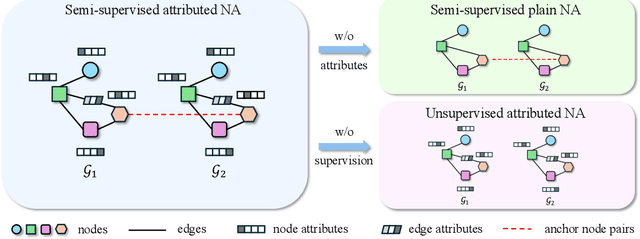
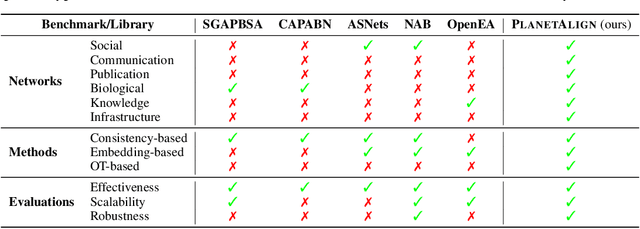
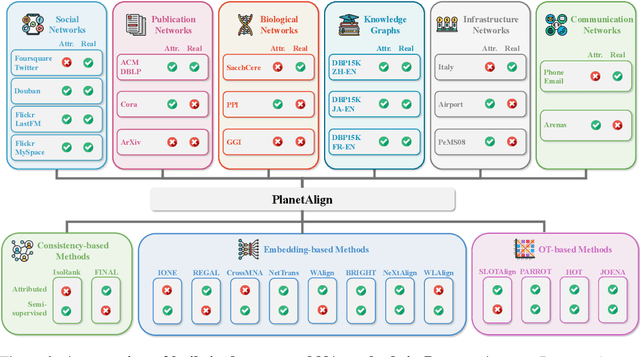
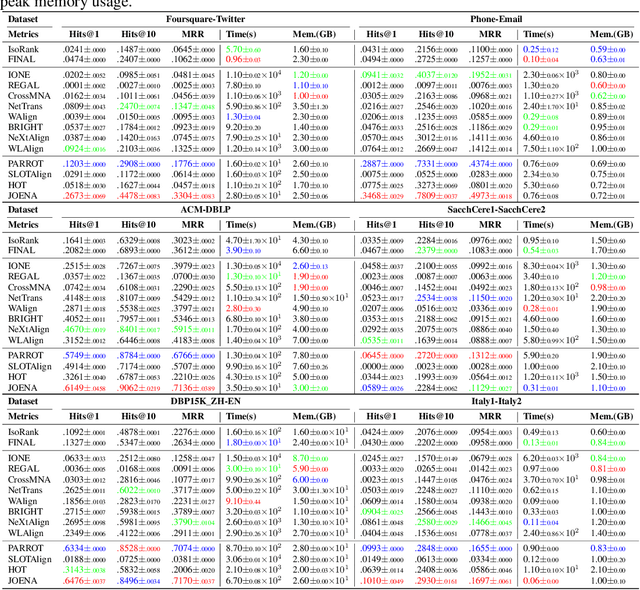
Abstract:Network alignment (NA) aims to identify node correspondence across different networks and serves as a critical cornerstone behind various downstream multi-network learning tasks. Despite growing research in NA, there lacks a comprehensive library that facilitates the systematic development and benchmarking of NA methods. In this work, we introduce PLANETALIGN, a comprehensive Python library for network alignment that features a rich collection of built-in datasets, methods, and evaluation pipelines with easy-to-use APIs. Specifically, PLANETALIGN integrates 18 datasets and 14 NA methods with extensible APIs for easy use and development of NA methods. Our standardized evaluation pipeline encompasses a wide range of metrics, enabling a systematic assessment of the effectiveness, scalability, and robustness of NA methods. Through extensive comparative studies, we reveal practical insights into the strengths and limitations of existing NA methods. We hope that PLANETALIGN can foster a deeper understanding of the NA problem and facilitate the development and benchmarking of more effective, scalable, and robust methods in the future. The source code of PLANETALIGN is available at https://github.com/yq-leo/PlanetAlign.
Pave Your Own Path: Graph Gradual Domain Adaptation on Fused Gromov-Wasserstein Geodesics
May 19, 2025Abstract:Graph neural networks, despite their impressive performance, are highly vulnerable to distribution shifts on graphs. Existing graph domain adaptation (graph DA) methods often implicitly assume a \textit{mild} shift between source and target graphs, limiting their applicability to real-world scenarios with \textit{large} shifts. Gradual domain adaptation (GDA) has emerged as a promising approach for addressing large shifts by gradually adapting the source model to the target domain via a path of unlabeled intermediate domains. Existing GDA methods exclusively focus on independent and identically distributed (IID) data with a predefined path, leaving their extension to \textit{non-IID graphs without a given path} an open challenge. To bridge this gap, we present Gadget, the first GDA framework for non-IID graph data. First (\textit{theoretical foundation}), the Fused Gromov-Wasserstein (FGW) distance is adopted as the domain discrepancy for non-IID graphs, based on which, we derive an error bound revealing that the target domain error is proportional to the length of the path. Second (\textit{optimal path}), guided by the error bound, we identify the FGW geodesic as the optimal path, which can be efficiently generated by our proposed algorithm. The generated path can be seamlessly integrated with existing graph DA methods to handle large shifts on graphs, improving state-of-the-art graph DA methods by up to 6.8\% in node classification accuracy on real-world datasets.
CATS: Mitigating Correlation Shift for Multivariate Time Series Classification
Apr 05, 2025Abstract:Unsupervised Domain Adaptation (UDA) leverages labeled source data to train models for unlabeled target data. Given the prevalence of multivariate time series (MTS) data across various domains, the UDA task for MTS classification has emerged as a critical challenge. However, for MTS data, correlations between variables often vary across domains, whereas most existing UDA works for MTS classification have overlooked this essential characteristic. To bridge this gap, we introduce a novel domain shift, {\em correlation shift}, measuring domain differences in multivariate correlation. To mitigate correlation shift, we propose a scalable and parameter-efficient \underline{C}orrelation \underline{A}dapter for M\underline{TS} (CATS). Designed as a plug-and-play technique compatible with various Transformer variants, CATS employs temporal convolution to capture local temporal patterns and a graph attention module to model the changing multivariate correlation. The adapter reweights the target correlations to align the source correlations with a theoretically guaranteed precision. A correlation alignment loss is further proposed to mitigate correlation shift, bypassing the alignment challenge from the non-i.i.d. nature of MTS data. Extensive experiments on four real-world datasets demonstrate that (1) compared with vanilla Transformer-based models, CATS increases over $10\%$ average accuracy while only adding around $1\%$ parameters, and (2) all Transformer variants equipped with CATS either reach or surpass state-of-the-art baselines.
ResMoE: Space-efficient Compression of Mixture of Experts LLMs via Residual Restoration
Mar 10, 2025Abstract:Mixture-of-Experts (MoE) Transformer, the backbone architecture of multiple phenomenal language models, leverages sparsity by activating only a fraction of model parameters for each input token. The sparse structure, while allowing constant time costs, results in space inefficiency: we still need to load all the model parameters during inference. We introduce ResMoE, an innovative MoE approximation framework that utilizes Wasserstein barycenter to extract a common expert (barycenter expert) and approximate the residuals between this barycenter expert and the original ones. ResMoE enhances the space efficiency for inference of large-scale MoE Transformers in a one-shot and data-agnostic manner without retraining while maintaining minimal accuracy loss, thereby paving the way for broader accessibility to large language models. We demonstrate the effectiveness of ResMoE through extensive experiments on Switch Transformer, Mixtral, and DeepSeekMoE models. The results show that ResMoE can reduce the number of parameters in an expert by up to 75% while maintaining comparable performance. The code is available at https://github.com/iDEA-iSAIL-Lab-UIUC/ResMoE.
Exploring the Performance Improvement of Tensor Processing Engines through Transformation in the Bit-weight Dimension of MACs
Mar 08, 2025Abstract:General matrix-matrix multiplication (GEMM) is a cornerstone of AI computations, making tensor processing engines (TPEs) increasingly critical in GPUs and domain-specific architectures. Existing architectures primarily optimize dataflow or operand reuse strategies. However, considering the interaction between matrix multiplication and multiply-accumulators (MACs) offers greater optimization potential. This work introduces a novel hardware perspective on matrix multiplication, focusing on the bit-weight dimension of MACs. We propose a finer-grained TPE notation using matrix triple loops as an example, introducing new methods for designing and optimizing PE microarchitectures. Based on this notation and its transformations, we propose four optimization techniques that improve timing, area, and power consumption. Implementing our design in RTL using the SMIC-28nm process, we evaluate its effectiveness across four classic TPE architectures: systolic array, 3D-Cube, multiplier-adder tree, and 2D-Matrix. Our techniques achieve area efficiency improvements of 1.27x, 1.28x, 1.56x, and 1.44x, and energy efficiency gains of 1.04x, 1.56x, 1.49x, and 1.20x, respectively. Applied to a bit-slice architecture, our approach achieves a 12.10x improvement in energy efficiency and 2.85x in area efficiency compared to Laconic. Our Verilog HDL code, along with timing, area, and power reports, is available at https://github.com/wqzustc/High-Performance-Tensor-Processing-Engines
Joint Optimal Transport and Embedding for Network Alignment
Feb 26, 2025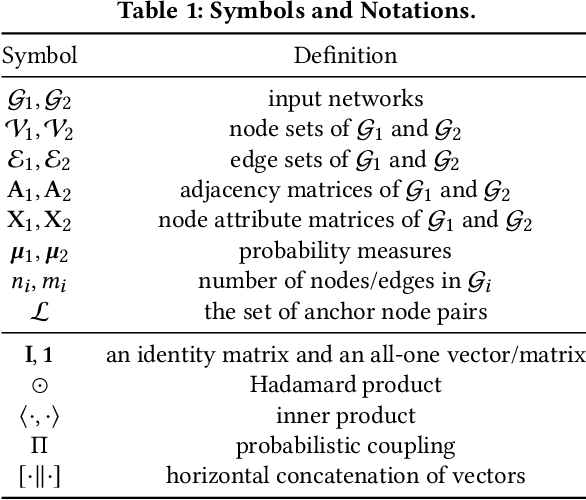
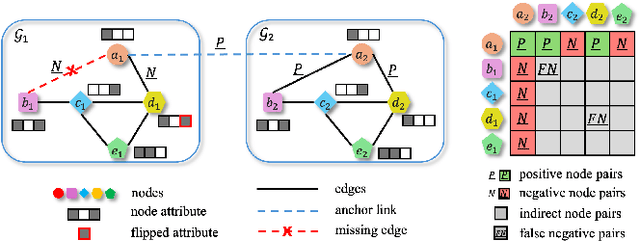
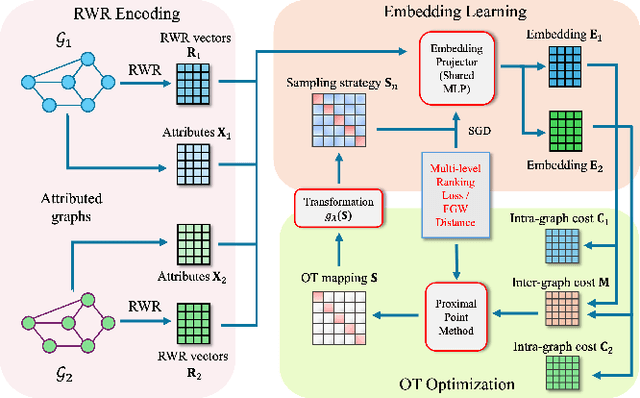
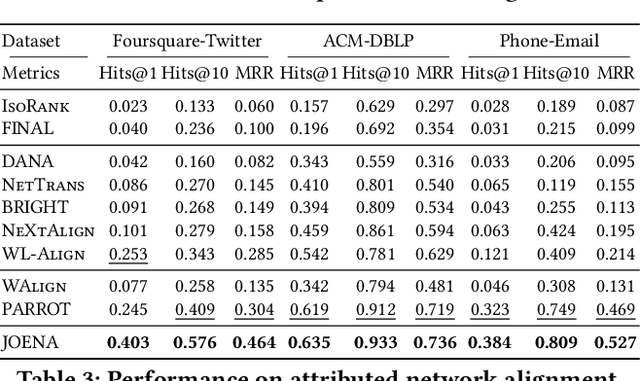
Abstract:Network alignment, which aims to find node correspondence across different networks, is the cornerstone of various downstream multi-network and Web mining tasks. Most of the embedding-based methods indirectly model cross-network node relationships by contrasting positive and negative node pairs sampled from hand-crafted strategies, which are vulnerable to graph noises and lead to potential misalignment of nodes. Another line of work based on the optimal transport (OT) theory directly models cross-network node relationships and generates noise-reduced alignments. However, OT methods heavily rely on fixed, pre-defined cost functions that prohibit end-to-end training and are hard to generalize. In this paper, we aim to unify the embedding and OT-based methods in a mutually beneficial manner and propose a joint optimal transport and embedding framework for network alignment named JOENA. For one thing (OT for embedding), through a simple yet effective transformation, the noise-reduced OT mapping serves as an adaptive sampling strategy directly modeling all cross-network node pairs for robust embedding learning.For another (embedding for OT), on top of the learned embeddings, the OT cost can be gradually trained in an end-to-end fashion, which further enhances the alignment quality. With a unified objective, the mutual benefits of both methods can be achieved by an alternating optimization schema with guaranteed convergence. Extensive experiments on real-world networks validate the effectiveness and scalability of JOENA, achieving up to 16% improvement in MRR and 20x speedup compared with the state-of-the-art alignment methods.
External Large Foundation Model: How to Efficiently Serve Trillions of Parameters for Online Ads Recommendation
Feb 26, 2025



Abstract:Ads recommendation is a prominent service of online advertising systems and has been actively studied. Recent studies indicate that scaling-up and advanced design of the recommendation model can bring significant performance improvement. However, with a larger model scale, such prior studies have a significantly increasing gap from industry as they often neglect two fundamental challenges in industrial-scale applications. First, training and inference budgets are restricted for the model to be served, exceeding which may incur latency and impair user experience. Second, large-volume data arrive in a streaming mode with data distributions dynamically shifting, as new users/ads join and existing users/ads leave the system. We propose the External Large Foundation Model (ExFM) framework to address the overlooked challenges. Specifically, we develop external distillation and a data augmentation system (DAS) to control the computational cost of training/inference while maintaining high performance. We design the teacher in a way like a foundation model (FM) that can serve multiple students as vertical models (VMs) to amortize its building cost. We propose Auxiliary Head and Student Adapter to mitigate the data distribution gap between FM and VMs caused by the streaming data issue. Comprehensive experiments on internal industrial-scale applications and public datasets demonstrate significant performance gain by ExFM.
Improving LLM General Preference Alignment via Optimistic Online Mirror Descent
Feb 24, 2025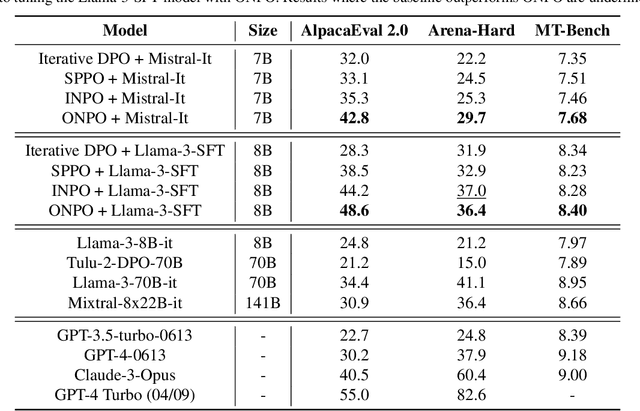
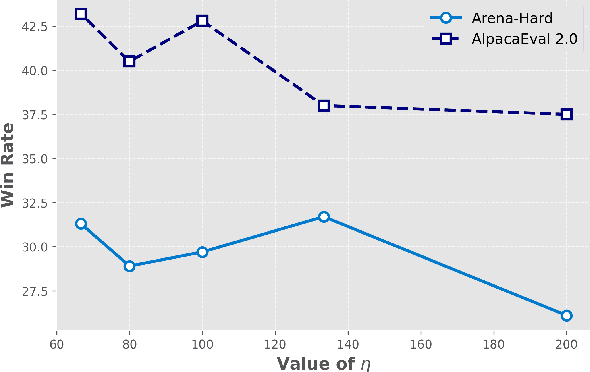

Abstract:Reinforcement learning from human feedback (RLHF) has demonstrated remarkable effectiveness in aligning large language models (LLMs) with human preferences. Many existing alignment approaches rely on the Bradley-Terry (BT) model assumption, which assumes the existence of a ground-truth reward for each prompt-response pair. However, this assumption can be overly restrictive when modeling complex human preferences. In this paper, we drop the BT model assumption and study LLM alignment under general preferences, formulated as a two-player game. Drawing on theoretical insights from learning in games, we integrate optimistic online mirror descent into our alignment framework to approximate the Nash policy. Theoretically, we demonstrate that our approach achieves an $O(T^{-1})$ bound on the duality gap, improving upon the previous $O(T^{-1/2})$ result. More importantly, we implement our method and show through experiments that it outperforms state-of-the-art RLHF algorithms across multiple representative benchmarks.
 Add to Chrome
Add to Chrome Add to Firefox
Add to Firefox Add to Edge
Add to Edge